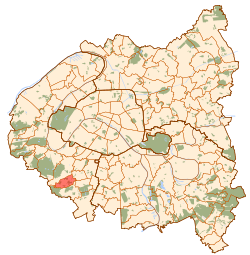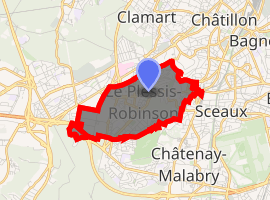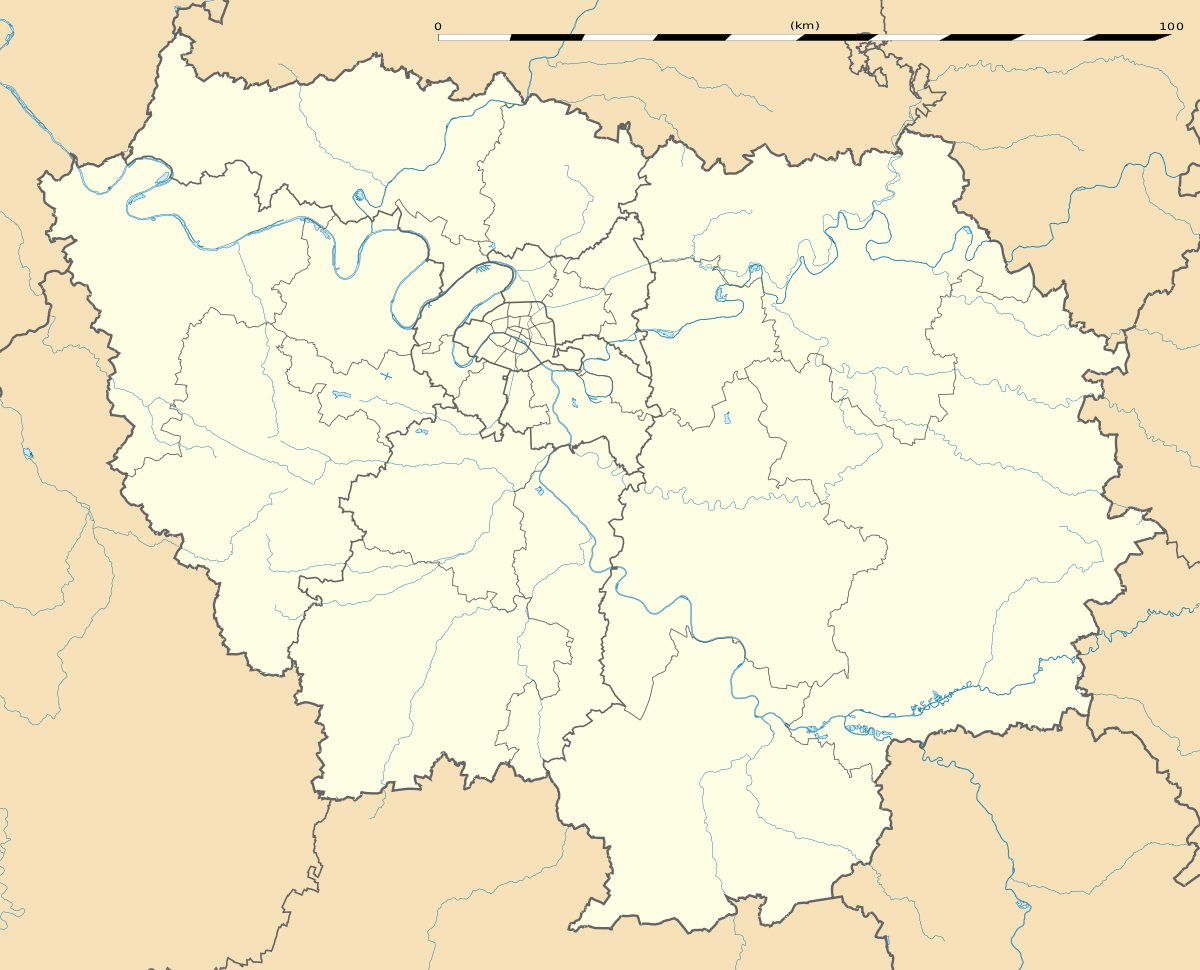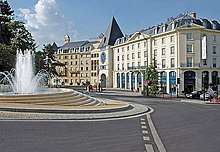Le Plessis-Robinson
Le Plessis-Robinson is a commune in the southwestern suburbs of Paris, France. It is located 10.5 km (6.5 mi) from the center of Paris. As of 2009, it has 26,581 inhabitants.[2]
Le Plessis-Robinson | |
|---|---|
 Le Plessis-Robinson, panorama | |
 Coat of arms | |
 Paris and inner ring départements | |
Location of Le Plessis-Robinson 
| |
 Le Plessis-Robinson Paris and inner ring départements  Le Plessis-Robinson Le Plessis-Robinson (Île-de-France (region)) | |
| Coordinates: 48°46′52″N 2°15′48″E | |
| Country | France |
| Region | Île-de-France |
| Department | Hauts-de-Seine |
| Arrondissement | Antony |
| Canton | Châtenay-Malabry |
| Intercommunality | Grand Paris |
| Government | |
| • Mayor (2014–2020) | Philippe Pemezec (UMP) |
| Area 1 | 3.43 km2 (1.32 sq mi) |
| Population (2017-01-01)[1] | 29,100 |
| • Density | 8,500/km2 (22,000/sq mi) |
| Time zone | UTC+01:00 (CET) |
| • Summer (DST) | UTC+02:00 (CEST) |
| INSEE/Postal code | 92060 /92350 |
| Elevation | 86–172 m (282–564 ft) (avg. 170 m or 560 ft) |
| 1 French Land Register data, which excludes lakes, ponds, glaciers > 1 km2 (0.386 sq mi or 247 acres) and river estuaries. | |
History
Plessis was first mentioned in 839 as Plessiacus apud Castanetum, meaning plessis near Castanetum. A plessis was a village surrounded by a fence made of branches. In 1112 the village church was founded, of which the romanesque tower still survives as the oldest monument of Le Plessis. At the end of the 12th the village was renamed Le Plessis-Raoul, after the local lord Raoul, chamberlain of king Philip II of France. In 1407 it came into the hands of Jean Piquet de La Haye, who built a castle in the village, now called Le Plessis-Piquet. In 1614 a monastery of the Congregation of the Feuillants was built in the village. In 1682 Jean-Baptiste Colbert, Minister of Finances under Louis XIV had a pond dug which fed the fountains of the nearby Château de Sceaux. Pierre de Montesquiou d'Artagnan purchased the estate in 1699, and expanded the gardens. In 1790, as a result of the French Revolution, Antoine Moullé was elected the first mayor of Le Plessis. The commune was renamed Le Plessis-Liberté. The monastery was nationalised and demolished.[3]
The commune was renamed back to Le Plessis-Piquet in 1801.[4] In 1848, a guinguette (cabaret) was established in the area as a suite of interconnected tree houses. It was named Le grand Robinson after the tree house described in Swiss Family Robinson, a novel itself named after Robinson Crusoe. Several other popular establishments arose in the area, and remained popular until the 1960s. In 1909, the commune of Le Plessis-Piquet was officially renamed Le Plessis-Robinson, after Le grand Robinson.[5] In 1854, Louis Hachette bought the castle and the grounds. He later became the mayor of Le Plessis-Piquet and a city councillor. The village and the castle were ruined in the War of 1870, but the castle was rebuilt by the Hachette family.[4]
New Urbanism

Today Le Plessis-Robinson is considered as the most significant project of New Urbanism in France. The mayor Philippe Pemezec is currently completely reshaping the city, in collaboration with the architects Marc & Nada Breitman, winners of the 2018 Driehaus Prize and part of the New Classical movement.
Transport
Le Plessis-Robinson is not served by the Paris Métro, RER, or the suburban rail network. The closest station to Le Plessis-Robinson is Robinson station on Paris RER line B. This station is located in the neighboring commune of Sceaux, 1.5 km (0.93 mi) from the town center of Le Plessis-Robinson.
Education
Primary schools include two groups of nurseries and preschools, five standalone nurseries/preschools (maternelles), four standalone elementaries, and Ecole Raymond Aumont.[6]
Secondary schools:[7]
- Two junior high schools: Collège Claude Nicolas Ledoux and Collège Romain Rolland
- One senior high school: Lycée Montesquieu
Sites of interest
- Château park
Twin towns
Le Plessis-Robinson is twinned with the following towns:[8]
References
- "Populations légales 2017". INSEE. Retrieved 6 January 2020.
- INSEE
- History of Le Plessis-Robinson (Middle Ages until Revolution)
- History of Le Plessis-Robinson (19th century)
- History of Le Plessis-Robinson (Guinguettes)
- "Les écoles." Le Plessis-Robinson. Retrieved on September 9, 2016.
- "Les établissements." Le Plessis-Robinson. Retrieved on September 9, 2016.
- Commune website
- "British towns twinned with French towns [via WaybackMachine.com]". Archant Community Media Ltd. Archived from the original on July 5, 2013. Retrieved 2013-07-12.
- "Woking Town twinning". The Woking Town Twinning Association. Archived from the original on 2013-06-12. Retrieved 2013-07-19.